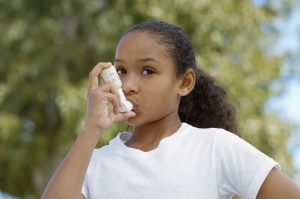
May is Asthma and Allergy Awareness Month. We’re in the midst of peak allergy season, which the Asthma and Allergy Foundation of America (AAFA) states is the perfect time to educate about these conditions.
According to AAFA, more than 16.2 million American children have asthma and allergies. Some children may have one or both of these conditions.
- About 5 million American children have asthma
- Close to 6 million American children have food allergies
- Nearly 5.2 million American children have hay fever, rhinitis, or nasal allergies
Asthma in Children
Talk to your child’s pediatrician if any parents or siblings have asthma or allergies because both can run in families. Children with asthma usually have symptoms before turning five. Their air passageways are smaller and more narrow, making it more difficult for air to enter and leave the lungs, especially if they experience asthma or allergies symptoms. When a child has a common cold or other upper respiratory illnesses, the inflammation can become worse, making it harder for them to take in air.
Asthma Signs and Symptoms
While it can be hard for parents to pick up on the signs that a child is suffering from asthma, it’s important to get in touch with your child’s pediatrician if you have any concerns about a lingering cough or trouble breathing. According to the American College of Allergy, Asthma and Immunology, the signs and symptoms of allergies can include:
- Coughing, especially at night
- A wheezing or whistling sound, especially when breathing out
- Trouble breathing or fast breathing that causes the skin around the ribs or neck to pull in tightly
- Frequent colds that settle in the chest
- Any of these become worse with irritants in the air (like smoke or strong smells or allergies like pollen, pet dander, or dust mites)
Asthma can usually be diagnosed with a medical exam. Get in touch with your pediatrician if your child is experiencing any of these signs or symptoms. There are many options for treatments to make breathing easier and to help control asthma symptoms for children.
Allergies in Children
While allergies do not cause asthma, allergies can make symptoms worse if a child already has asthma. Common allergens and irritants are pollen, pet dander, dust mites, and mold. These are known as hay fever, rhinitis, or nasal allergies Allergies can also be categorized as food allergies.
Food Allergies
Allergies are different from food sensitivities or intolerances. Children with food allergies have an immune response to certain proteins in foods. Food allergy symptoms can be more severe than the symptoms of food sensitivities or intolerances.
One of the possible effects of a food allergy is called anaphylaxis. This is a severe allergic reaction that affects the entire body. It can include a wide range of symptoms that appear quickly. The following symptoms may be signs of anaphylaxis especially if they appear suddenly after exposure to a possible allergen:
- Shortness of breath or trouble breathing
- Wheezing or coughing
- Tightness in chest
- Difficulty swallowing
- Tight feeling in throat
- Swelling of the lips or tongue
- Rash, redness, or hives and/or pale and bluish skin
- Weak pulse
- Sneezing
- Stuffy or runny nose
It’s important to be aware of any food allergies your child has so you can adjust their diet to avoid trigger foods. Read more on the eight most common food allergies in kids here on our blog.
For More Information
As a parent, we know your child’s health is of the utmost importance. At HealthPark Pediatrics, we are here to be a resource. If you have questions or concerns about your child’s asthma or allergies, parents in the Raleigh area can call us at (919) 896-7066 for assistance.
At HealthPark Pediatrics, the health and safety of our staff and patients is our top concern. We are taking steps to ensure that you and your child will be safe while visiting our office. This includes using a separate entrance for sick visits, limiting the number of staff and physicians, observing social distancing guidelines, and offering telemedicine visits.



